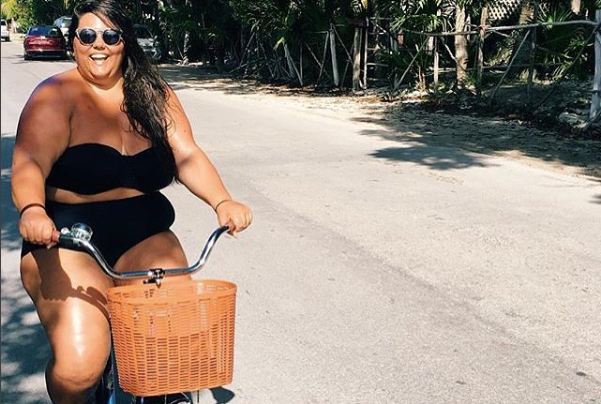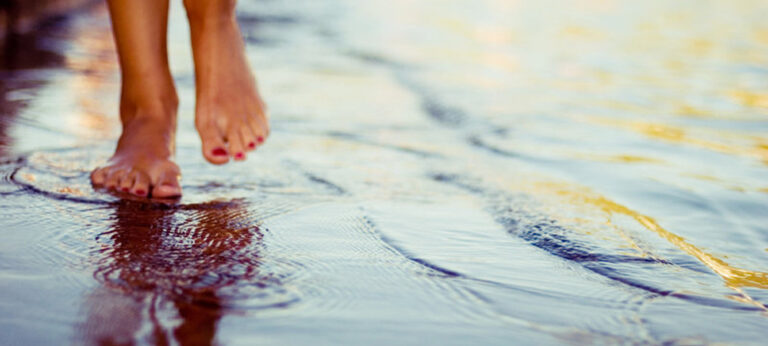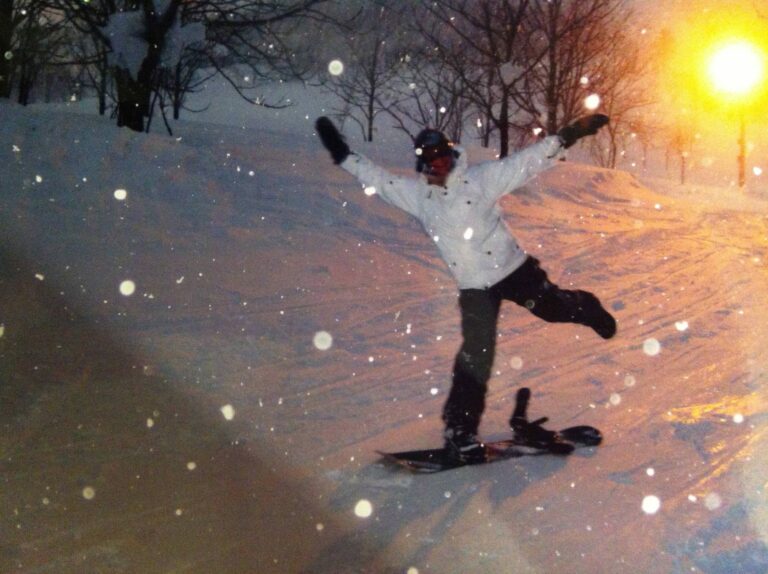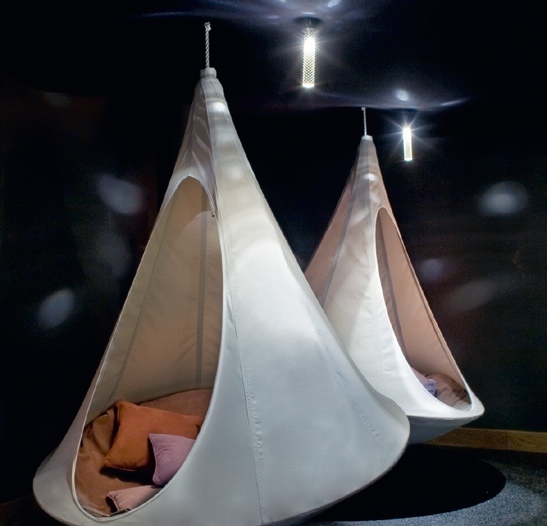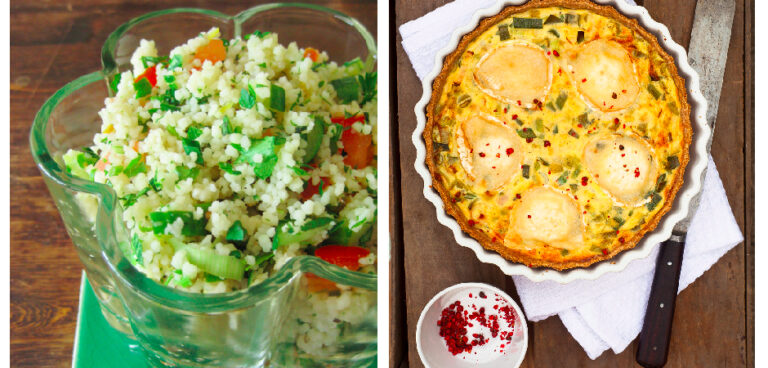Dreaming of a buff body? We’ve stolen the ultimate moves from top snow pros to get you the must-have muscles for a trip to the slopes.
Words by Amanda Maclean
Illustrations by Katie Wood
Unzip a snow pro’s baggies and you’ll be impressed what lies beneath: buns of steel, abs to die for and legs that are oh-so toned. To perform well, stay strong and injury-free, mountain goddesses train hard pre-season, but it’s not just the pros who need to prep their bodies for winter. Whether you’re planning a one-week jaunt or a four-month stay in the mountains, get fit for riding now and look like an action goddess for the festive season and beyond. Don’t forget to warm up before you exercise and stretch out afterwards.
BUTT SHAPERS
Barbell Squat
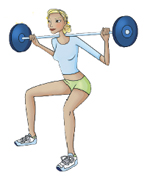
What it does: Gets deep into the gluteus muscles of the backside to really sculpt and tone.
How to do it: Start with a light weight, lift the bar overhead and rest it on your shoulders. Stand tall with your feet just wider than shoulder-width. Lower your butt out behind you until your thighs are parallel (or nearly parallel) with the floor, and come back to standing, keeping your weight through your heels, not your toes, throughout the movement. Do two sets of 15 repetitions with a 30-second rest in between. Perform three times a week.
Variations: Single leg squat, squat jump.
Recommended by: Jenny Jones, top snowboarder for Billabong.
Hip Extension
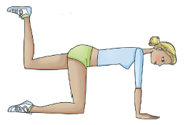
What it does: Gives your bottom a lift by honing in on the main gluteus maximus muscles. Boosts explosive power for the piste, park and pipe.
How to do it? On hands and knees, raise one leg out behind you, keeping the knee bent, until the thigh is parallel with the floor, and then lower. ‘Squeeze the bum at the top of the movement to isoloate the muscle,’ says Baird. Do two sets of 15 reps, changing legs between sets. Perform three times a week.
Variations: Machine hip extension
Recommended by: Top freeskier Andrea Binning, who rides for Red Bull.
Top tips for a sexy butt
• ‘The stepper and cross-country machine are great for nailing the arse!’ says Jenny Jones.
• ‘Take an indoor cycling class,’ says Norwegian snow pro and Roxy girl Lisa Wiik.
• ‘Keep it fun with capoeira, gymnastics or trampolining,’ says Nikita snow pro Julia Baumgartner.
‘A toned butt injects power and efficiency into movement – whether you’re riding, running or cycling.’ – Top UK personal trainer Jamie Baird
CORE STRENGTHENERS
Bosu Four Square

What it does: Fires up the deep abdominal muscles and lower back (the core muscles), builds core stability and improves body awareness.
How to do it: Get down the gym and find a foursome to play the game. Place four Bosus, platform side up, in a square approximately two metres apart, and fetch a weighted medicine ball (1-2kg). Step on the Bosus carefully, and find your balance first. If it’s too hard, switch to dome side up (as shown). When you’re all ready, throw the ball to each other, left, right or across, and try to stay balanced. Game rules: fall off and you’re out. The last person standing on the Bosu is the winner.
Variations: Vary the weight of the medicine ball, use a tennis ball and bounce before you catch, up the tempo, or spread the Bosus further apart. Just one partner? Throw the ball back and forth.
Recommended by: Cooler cover girl Kristi Leskinen: ‘A crew of us girls meets at the gym every day for pre-season training. To keep it fun, we play games and this one is great for building core stability.’
Single leg plank
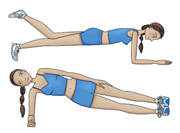
What it does: Guards against injury by strengthening the spine, lower back and deep abdominal muscles. Challenges the stabilising muscles from head to toe.
How to do it: Lie face down and rest on your forearms and toes. Pull your belly in towards your spine and, keeping a straight line from your shoulders to your ankles, raise yourself up so only your forearms and toes are resting on the floor. Keeping your tummy tucked in and your hips in alignment, raise one foot from the floor. Use your corset muscles to maintain the hold for 30 seconds, or one minute if you’re strong enough. To make the exercise easier, keep both feet on the floor and hold.
Variations: To hone the obliques, the vital riding muscles at the sides of the trunk, perform the side plank. Lie on your right side and lean on your right forearm keeping the elbow in line with your shoulder. Now raise your hips from the floor until your body is in a straight, diagonal line. Be careful not to drop your hips or tilt them forwards or backwards. Try to hold the balance for 30 seconds to one minute, and keep breathing throughout. Switch to the other side. Do these balances every day to build up core strength, and work up to longer holds.
Recommended by: Top Norwegian snowboarder Lisa Wiik, sponsored by Roxy.
Sit up a minute!
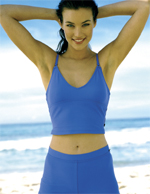
Regular sit-ups will help tone the surface area of the stomach, but they won’t work the deeper, corset muscles that wrap around the trunk (the transverse abdominis), and these are the most important core muscles for riding. A strong core will boost your balance on a board or skis and will help stabilise the pelvis and spine when you move, twist and turn. The best way to build core strength is with balance exercises – on one leg, on a wobble board, a stability ball or Bosu – because the core muscles have to work hard to keep the body stable.
Top tips for a strong core:
• ‘Buy a stability ball. A simple but effective exercise is to balance on it on your hands and knees,’ says Olympic snowboarder Lesley McKenna. To make the exercise harder, raise one arm out in front of you and the opposite leg out behind you. Progress by balancing on just your knees, and when you’re confident try standing up.
• ‘Go surfing and do plenty of yoga and pilates,’ says snowboard coach and Our Camp founder Gilly Seagrave.
• ‘Do single leg squats with your eyes closed,’ says Vicci Miller, GB snow pro. ‘The exercise builds core stability and ligament strength in the legs, both of which help to keep injury niggles at bay.’
‘A strong core is crucial for power, balance, injury prevention, bending and twisting.’ – Darren Roberts, strength and conditioning coach, team Red Bull physio unit.
THIGH TONERS
Barbell lunge
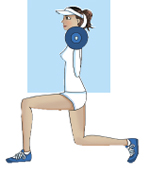
What it does: Strengthens the quads, hamstrings and butt; improves balance and agility. Strong thighs will take pressure off the knees when you ride and reduce the likelihood of ligament damage and injury.
How to do it: The lunge is a great exercise to do to guard against knee problems, but it can also provoke knee strain if you perform it incorrectly. The lunge should be a 4-step sequence, which you can speed up or slow down accordingly. For this barbell exercise, perform it slowly and in control.
1. With a weighted barbell rested on your shoulders, your feet shoulder-width apart and your hips facing forwards, take a large stride forwards with your right leg.
2. Keeping your chest upright, slowly bend both knees towards the floor (being careful not to tip your front knee in- or outwards) until your front thigh is parallel, or nearly parallel, with the floor and your knee is in a vertical line with your ankle (not over your toes).
3. Slowly return to an upright position, keeping your weight through the front heel, not the front toe, as you come up.
4. Step back to the start position and repeat on the other leg.
Variations: Feel knee strain? Remove the weight and don’t bend so low. Too slow? Remove the barbell and do walking lunges, or power lunges, but keep the front knee in line with your ankle as you bend down to avoid stressing the joint.
Recommended by: GB Olympic snowboarder Lesley McKenna.
The Ski Circuit
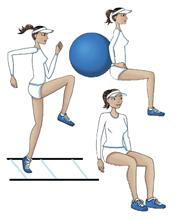
What it does: Prepares your pins for munching moguls, stomping landings and attacking the pistes on skis and a board. ‘Take it easy for the first four weeks until you’ve built up strength in the legs and core and, if your joints are injury-prone, avoid the circuit and do low impact work instead,’ says Baird.
How to do it: Gather some mates, find some space outside, in a sports hall or at the gym, and make your own ski circuit, marking up an exercise for each station. Make it fun by adding skipping ropes,agility ladders, bollards, benches, Bosus and stability balls. ‘Include plyometric and isometric exercises that simulate ski and snowboard actions,’ says Baird. Do 45 seconds at each station, and two circuits. Do the circuit once or twice a week and up the tempo after one month.
Plyometric exercises: Sprints, star jumps, multidirectional ski jumps, jump squats, high knee hops (on the floor or using the equipment). Skip solo or in threes with one at each end of the rope and the skipper in the middle.
Recommended by: Kristi Leskinen, top freeskier
Isometric exercises: Seated squat, seated ball squat (with a stability ball), V-sits, and balance holds of all descriptions. ‘Next time you’re at the gym ask a fitness instructor to demonstrate a dozen ways to balance on a stability ball,’ says Baird. Seated squat/seated ball squat: Lean against a wall (or against a stability ball) in the sitting position with your thighs parallel with the floor, your ankles in line with your knees, and your hands by their sides. Hold the position for one minute, keeping the weight towards your heels. Try to do this exercise every day to build leg strength.
Recommended by: Our Camp co-founder and snowboard coach Sonia Shaw. ‘The seated ball squat is a killer, but it works’ she says.
The science bit
Plyometric: Legs need to work like coiled springs on the mountain, stretching and flexing on demand in order to absorb bumps, take-offs, landings, and the unexpected. Plyometric exercises – hopping, skipping and jumping movements – are ideal pre-season training exercises because they mimic dynamic riding actions and develop the recoil capacity of the leg muscles.
Isometric: Untrained muscles feel the burn quickly because they’re not used to holding the bent-leg, squat stance for long periods of time. Pre-season isometric training, keeping the thigh muscles tense but static, will develop your tolerance for muscle burn. ‘The seated squat against a wall or stability ball is the best preseason
exercise for the thighs,’ says Baird.
Top tips for firmer thighs:
• ‘Get into mountain biking, because it’s a great toner for the legs,’ says Canadian snow pro Marie France Roy.
• ‘Do cardio dance classes like me,’ says coach Gilly Seagrave.
• ‘You can’t beat running,’ says ski pro Andrea Binning.
‘Legs take lots of flack on the mountain and must be strong and agile for landings, bumps and turns.’ – Ski performance coach Warren Smith.

